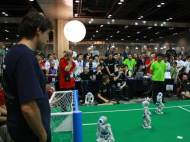Team B-Human won the RoboCup 2010 Standard Platform League
 The RoboCup is a fascinating combination of innovative research and one of the world’s most popular team sports – soccer. Standard Platform League is a league in which all teams use the same robot platform (Aldebaran’s Nao humanoid robot we described in the last year’s article about RoboCup 2009) so the teams are challenged to develop better algorithms and team strategies in order to win.
The RoboCup is a fascinating combination of innovative research and one of the world’s most popular team sports – soccer. Standard Platform League is a league in which all teams use the same robot platform (Aldebaran’s Nao humanoid robot we described in the last year’s article about RoboCup 2009) so the teams are challenged to develop better algorithms and team strategies in order to win.
This year’s winner is team B-Human from Germany. B-Human is a collegiate project at the Department of Computer Science of the University of Bremen and the DFKI research area Safe and Secure Cognitive Systems. The goal of the project is to develop suitable software in order to participate in several RoboCup events. The team consisted of students in their advanced study period, and it was led by researchers from DFKI.
After they have won the Standard Platform League competition they published their code releases as well as a comprehensive documentation in order to share their achievements with other developers. In order to make their robots even better for RoboCup 2010, they have developed precise self-localization algorithm that proved to be an important part of their successes in robot soccer competitions as well as in the technical challenge.
They have created a more sophisticated model for the center of mass movement that is based on two alternating inverted pendulums and a preview controller. This model allows eliminating the need of a double-support phase by dynamically adjusting the point in time at which the support leg alternates. Therefore, the load on the joints for bridging over larger distances can be reduced. In addition, the stabilization methods used to keep the balance of the gait were partially integrated into the model to react on external disturbances in a farsighted manner. The results are very promising since the maximal reachable velocity has almost doubled.
During all previous tournaments, including the RoboCup German Open 2010, the detection of opponents was available only via the ultrasonic sensors. This approach is quite inaccurate and applicable for short distances. In order to surpass that problem, they used color segmentation and the subsequent detection of pink and blue regions representing the team markers. Afterwards, the degree of whiteness of the marker regions’ environment is determined by means of a scan line grid that is orthogonal to the principal axis of inertia of the team marker region. They are using this feature to aim more accurately at the largest part of the opponent goal that is not blocked by the goal keeper or other robots.
In the previous RoboCup, some teams demonstrated that a diving goalkeeper can be very effective to block long-distance shots. However, a dive also bears the risk of damaging the robot. Hence, they have carefully created a diving motion that allows their goalie to dive without taking any serious damage.
Aside the fact they won the RoboCup 2009 Standard Platform League soccer competition, their total goal score this year was 65:3. However, they ranked 4th (behind rUNSWift, Austin Villa and CMurfs) in the technical challenge where their competition did beat them in dribbling (the robot’s abilities to pass, open and dribble were also judged).









Leave your response!